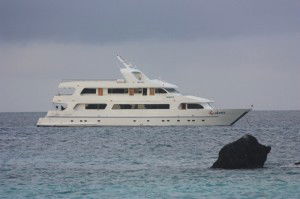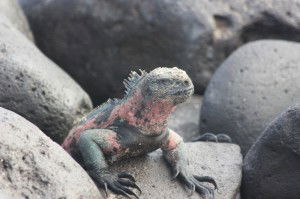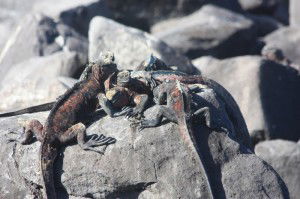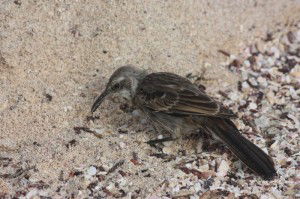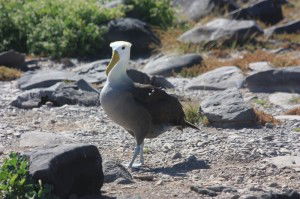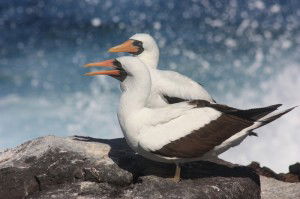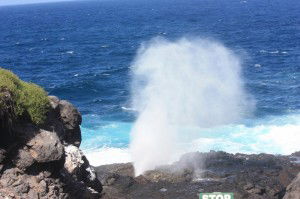Galapagos Adventure—Day 5
As I write this blog, it is morning and I’m looking out my cabin window at what seems like an endless sea of blue. Yesterday we visited Española, the southern- and eastern-most island. It is also the oldest of the islands and is covered in vegetation. We were greeted on shore once again by Sally Lightfoot crabs and sea lions. Many of the sea lions were nursing young.
We spot several marine iguanas. They are hard to see against the rock due to their mainly black color. However, the marine iguanas on Española also have a beautiful red color because of the type of algae they eat in the ocean at this location. Marine iguanas are the only iguanas to feed in water. This is atypical behavior for reptiles, which are cold-blooded. They warm themselves in the sun until midday and then swim into the ocean, eat for 10-15 minutes, then begin a perilous journey back to shore to warm up again. When we were leaving the island around noon, we saw several of them swimming. They have very long, sharp claws which allow them hold onto rock and other materials when they are in the ocean eating so they are not swept away by the current. The claws also allow them to climb to amazing heights. Later on Española we saw many of them high up on rocks that looked, from a human perspective, impossible to climb. For more on these amazing creatures and their relationship to land iguanas, please see Creation’s Hidden Potential.
As we watched the sea lions and marine iguanas, very curious birds began to appear at our feet. They are the hood mockingbird. Mockingbirds were a favorite of Darwin when he visited the islands. According to our naturalist, the mockingbirds have a type of symbiotic relationship with the marine iguanas. They eat parasites and insects off the iguanas and serve as an alarm system if they spot a Galapagos hawk. The iguanas cannot make noise to warn each other about danger so the birds do it for them. When the birds screech in a certain way the iguanas know there is danger and will quickly run for cover.
The Galapagos hawk is a somewhat elusive bird on the island and hard to get a good picture of! They are the top of the food chain here and have no predators. Although all the Galapagos hawks are considered one species, genetic studies have shown large differences in their genetic makeup and there are also differences morphologically and behaviorally among populations on different islands. The hawk does not like to fly long distances so it seems that once they reach an island they mainly breed only within the island population. This has led scientists to conclude that they may be in the early stages of speciation.
We saw some blue-footed boobies and the Nazca booby. The Nazca are mostly white with a sort of black mask. Their feet are a dullish brown color and their courtship ritual mainly involves clacking their beaks together. Among the Nazca boobies we also spot several waved albatross. They have a tremendous wing span (6–7 feet) and will fly out to eat in the ocean for two months at a time. They stay in flight for the entire two months (wow!) and then ride the ocean current back to the island as a group. We could see “lines” of them far out into the ocean coming back to the island. Because of their massive wingspan, they have to take off from a high cliff in order to get airborne, and Española is a perfect place for them because of the many cliffs here. We also saw a couple of waved albatross eggs and nests.
Many yellow warblers fly around us and we spot the large cactus finch (one of Darwin’s finches that is found only on this island). They are hard to spot and don’t “pose” as much as the other animals! We also got to see an amazing blowhole that throws water (and sometimes marine iguanas!) a hundred feet into the air.
Tomorrow we visit Floreana which has about 120 human inhabitants. According to our naturalist it is called “mystery island” because some former human occupants of the island have seemingly disappeared. I slept much better that night due to the ship finishing its course before midnight! Enjoy the pix!

Answers in Genesis is an apologetics ministry, dedicated to helping Christians defend their faith and proclaim the good news of Jesus Christ.
- Customer Service 800.778.3390
- Available Monday–Friday | 9 AM–5 PM ET
- © 2025 Answers in Genesis


